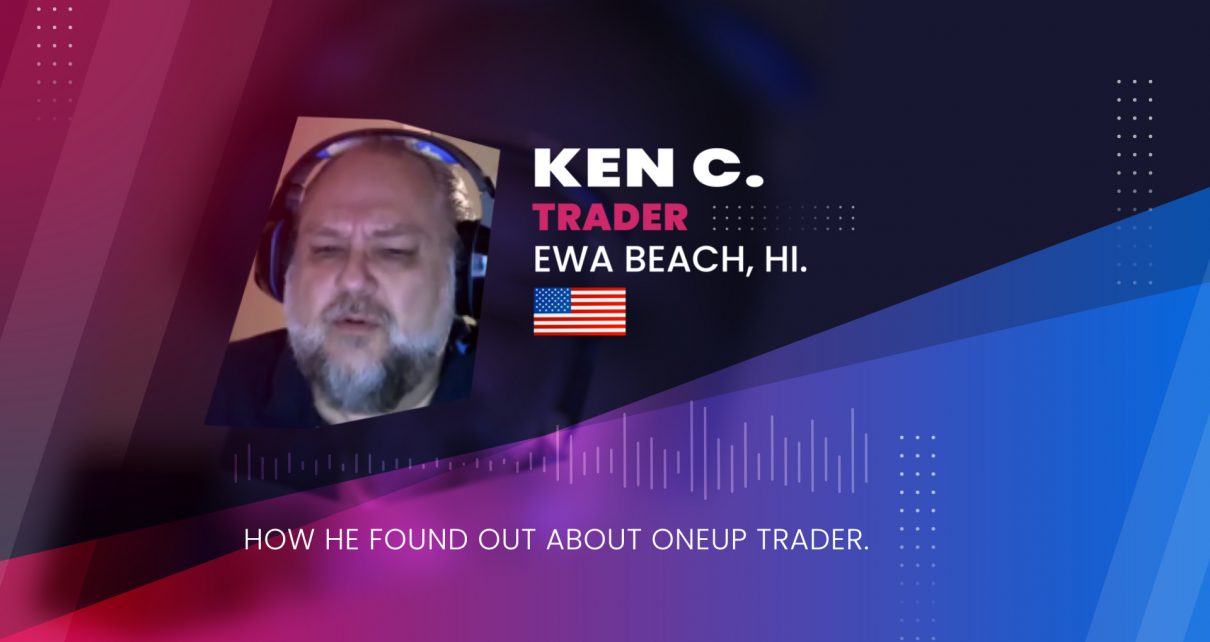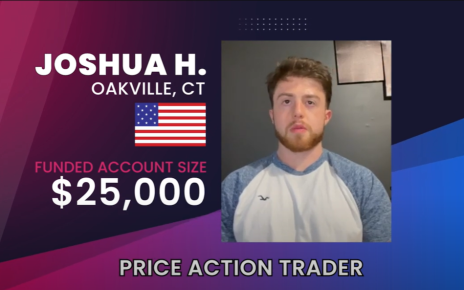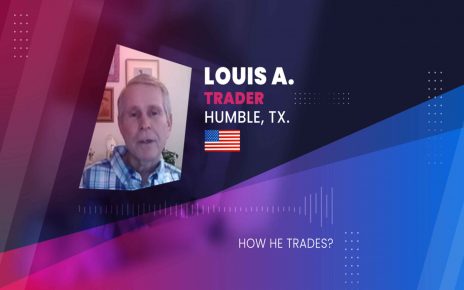Ken C., a funded trader from Ewa Beach discusses his experience with OneUp and reveals how he found OneUp. He compares his experience with OneUp Trader and Topstep and mentions why he chose OneUp and not Topstep. For Ken, OneUp’s rules assist traders to make more money compared to Topstep. Want to hear and learn a few success tips from him? You can listen to the interview by visiting here.
How he found OneUp
According to Ken, he has a Topstep account but was looking for something other than Topstep. He wanted a funding service with a structure, setting, and trading rules that will allow him to make money. He thinks the OneUp setup makes it easier for traders to succeed.
Topstep, on the other hand, was designed to make traders fail. They have restrictive rules which can impede the trader’s success. The first thing he observed as soon as he started with OneUp is that it offers a far bigger account size which he thinks is a great feature and a plus for OneUp. He searched for TopStep alternatives, but couldn’t remember precisely how he found OneUp.
Why choose OneUp and not Topstep?
With Topstep, you have to triple what you’re allowed to lose and you have to do it twice, which means you have to make 6 times more money than you are allowed to lose which he thinks is over-restrictive. According to him, the only way a trader can fulfil this rule is to do scalping and go short for every trade, which he thinks doesn’t allow traders to make money.
The best trading approach for winning big, according to him, is when they’re allowed to look at trades, wander a little to find a promising opportunity. Topstep settings make it difficult for traders to achieve that, and that’s why he says that TopStep is not designed for traders to win.
He is aware that trading longer time frames mean more risks. All you need to do is set a good stop when you want to trade long to ensure you don’t get swayed by the market noise.
Besides, he thinks that going through one evaluation process is a huge task, let alone going through the step again a second and a third time. People should be allowed to have a trade, he says. While he sometimes day trades, when he does, he goes all in and all out. However, when the market is trending, he tends to trade in the direction of the trend. And if he goes 6, all-in-all-out on a regular day, if the market is trending, he minimizes his trades to a 4 all-in-and-all-out.
His trading plan
He compares a trading plan with a poker plan. A professional poker player has to have a plan, but he must equally be able to vary it anytime. Therefore, he thinks a trading plan needs to be flexible and a trader has to vary it from time to time.
The reason is you can’t do the same thing in different situations and succeed with it. It doesn’t work that way. When you’re trading a vulnerable day, you just have to do some adjustments. You must first start working with a trading plan and be able to stick with it mentally. However, it is vital to vary the trading plan as market conditions changes. Nonetheless, you need to know how to alter your plan rightly without wiping yourself out. Try to have a good trading plan, and at the same time, know how to defocus from it when required.
His experience with the OneUp signup process and customer support team
He said that the support team is helpful, and when he got worried about over-reading things, he called for some help, and the team was happy to assist him. And when he went back to trade, he could more easily navigate through trades, which handled his worry. He thinks that the way OneUp email is set up is very good. Whenever he calls for help, the team always puts him at ease and says, “we will get you through”. He thinks the OneUp team is great, awesome, and always nice!
About OneUp Trader’s Dashboard and consistence
OneUp has updated its trader’s dashboard and it currently works a lot better than it did previously. He mentioned a day he lost 4000 dollars, but he didn’t think the loss has anything to do with the OneUp trader’s platform. He mentioned that the loss was because of the lack of power in his locality. Nevertheless, he would consider it as inconsistent because it wasn’t caused by the OneUp trading platform. However, the next day, he recovered from the loss and started to trade positively again. Luckily, the loss didn’t blow up his account and he could get back on his feet the next day.
His experiences with evaluation, funding, and trading on the OneUp platform
Ken has got funding from OneUp seven times. So, he says he is not afraid to blow out his account, but at the same time, he doesn’t play it wildly. He wished there is a way he could figure out the bad days to avoid getting down three to four times in a row. However, he learned to minimize his contract size and cut it down by half when he loses a trade until he gets back his courage and gets positive again.
That way, he solved the many problems that made him blow up so many of his accounts. When you start doubling your trades, he says, you end up blowing your account quickly. He did everything the hard way.
How he learned to trade
He doesn’t hang up with any trader and doesn’t even know a single trader. He learned and taught himself everything. He learned through YouTube videos and all sorts of different things. According to Ken, it was fun to lose when he started trading, but the loss was small, it was easy to overcome. By having many accounts, and blowing them up, he learned a lot, but he doesn’t foresee it happening again.
Learning to lose more than winning
He thinks that loss is an inevitable part of trading and you have to blow up a couple of accounts, he says, it’s a learning process. Once you discover how to win, after that, you’re going to discover how to lose because if you focus on only winning as a trader due to fear to lose, you’ll restrict yourself too much. And if you’re trying too hard, you’re going to lose.
In the end, trading is a zero-sum game and a strange business where any money you make is someone’s loss. The most important thing is to learn how to lose. It’s more essential than learning how to win because if you learn how to lose and then how to win, you are going to set up for yourself a couple of accounts. However, because he learned to trade all by himself and in isolation, Ken said he learned the opposite way. You can listen to him here.
How the process from Evaluation to funded account went for him
From his experience, the evaluation process takes about 3 to 5 days. When he passed through the funding and evaluation stages, he had to fill out a lot of questionnaires and different kinds of stuff to explain how he trades, why he trades, and what he does. His thinks the reason for all those questions is for OneUp to compare your trade with those of other traders and figure out whether or not it is going to work out.
As a beginner, he started by managing his trades well, and when he does that for a day or two, it means he’s winning. His trading strategy is mostly looking for reasons why a trading opportunity may pop out in one direction or the other within the next minute. If you can do that and keep that constant, you’re going to make a living trading, he says.
He has never experienced a problem with the OneUp funding partners he worked with, and the trading rule for him is the same during the evaluation period and when he got funded. OneUp team sent him a congratulatory message when he passed the funding evaluation, and he thinks it is fantastic.
What he thinks about other companies
He thinks Lulu was interesting because the team commonly gets into the trading room with their funded traders. However, he had to quit his account with them because they kept changing the rules all the time. Also, they only allow traders to withdraw their wins once a month, and the limit the trader could withdraw is 1000 dollars, even if he made a win of 15,000 dollars. He thinks the rule doesn’t make sense. Why will a trader allow the company to hold his money until whenever? He thinks, it may be Topstep’s strategy to make traders trade long term but there was really no reason for that because if a trader is winning, he or she would want to trade long term.
He thinks some of the trading companies out there are weird, but he realized that OneUp Trader wants to do something new and is doing it well. While he still has a Topstep account, one of the things that caught his attention about Topstep is the misrepresentation of their traders’ achievement by their marketing team.
Withdrawal with OneUp Funded Partner
From Ken’s experience, OneUp funded partners want you to withdraw your funds at a specific time each month. They wire the money into your account the next day when you request it, but they prefer you to do it at the same time every month. He mentioned that a OneUp trader withdrew 2,000 dollars in a single day and wished it was him.
What he likes best about OneUp and his suggestion for OneUp Trader
One of the things he likes the most about OneUp is that everybody on the team is fantastic and awesome. OneUp trading rules are always nice, simple, and there is nothing subjective. He mentioned when he traded wrongly, the team got in touch and said, “you screwed up! How can we help you make it better next time”? And he thinks that was fantastic.
As for suggestions he has for OneUp Trader, he says if he could be allowed to open two accounts because of the regular power issues he has, it will help him keep one account going if he loses one account to power. That would prevent him from going over the assessment process again. Having two different accounts will allow him to alternate between the two accounts to meet his daily trading goals which would be perfect.
He further mentioned that all OneUp Trader’s emails and how they are set up are really good. The two accounts will allow him to exit a trade from one account earlier. Having the two accounts will make him a better trader and help him to maintain his daily trading goal.
Final advice
Do have a trading plan, write it down, he says. Don’t be afraid to trade with it but test it. Also, you need to learn how to lose. Grab one contract first and don’t be afraid to lose. Do not think you have to do it within 15 days. Not passing evaluation within 15 days, won’t make OneUp think you aren’t a great trader. Take your time, be consistent and once you do, learn how to vary your plans and the right time to do it. Don’t be afraid to minimize your contract on a vulnerable day. Learn how to vary your contract. Learn how to lose first; then learn how to win. Follow this link now to hear him speak.





